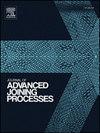Friction stir processing of AA1050/AA5052 composite produced by accumulative roll bonding process: Microstructure and mechanical properties
IF 4
Q2 MATERIALS SCIENCE, MULTIDISCIPLINARY
引用次数: 0
Abstract
A layered composite of AA1050-AA5052 alloys was fabricated through roll bonding, and accumulative roll bonding (ARB) and subsequently subjected to friction stir processing (FSP). In this process, the annealed AA5052 and AA1050 sheets are used as raw materials. At first, preheating at 200 °C for 6 min preceded the rolling process in an induction furnace, achieving a 67 % reduction in the cross-sectional area. Then, two ARB stages were conducted. At the flow, the FSP process was conducted at constant transversal speeds of 750 rpm and 1180 rpm. Microstructural details were analyzed using optical microscopy (OM), scanning electron microscopy (SEM), and electron backscatter diffraction (EBSD). Mechanical properties were assessed through tensile test, microhardness measurement, and wear test. The results showed that recrystallization occurred due to FSP applied to the rolled sheet. The tensile strength after ARB and FSP was measured as 270 and 150 MPa, respectively. These values show an increase of 3.3 times and 1.8 times, respectively, compared to annealed AA1050. The maximum elongation after ARB and FSP was measured at about 9 and 30 %. Work hardening and grain refinement, respectively, had a significant role in increasing the elongation of the AA1050/AA5052 composites created by ARB and FSP. Furthermore, FSP enhanced the wear resistance of the AA1050-AA5052 composite created with two ARB steps by 70 %.
累积轧制复合材料AA1050/AA5052的搅拌摩擦加工:显微组织与力学性能
通过轧制结合和累积轧制结合(ARB)制备了AA1050-AA5052合金层状复合材料,并进行了搅拌摩擦处理(FSP)。本工艺以退火后的AA5052和AA1050板材为原料。首先,在感应炉中进行轧制过程之前,在200°C下预热6分钟,使截面积减少67%。然后进行了两个ARB阶段。在流动中,FSP过程以恒定的横向速度750 rpm和1180 rpm进行。利用光学显微镜(OM)、扫描电镜(SEM)和电子背散射衍射(EBSD)分析了显微结构细节。通过拉伸测试、显微硬度测试和磨损测试来评估机械性能。结果表明,FSP对轧制薄板产生了再结晶。经ARB和FSP处理后的拉伸强度分别为270和150 MPa。与退火后的AA1050相比,这些数值分别增加了3.3倍和1.8倍。经ARB和FSP处理后的最大伸长率分别为9%和30%。加工硬化和晶粒细化分别对ARB和FSP制备的AA1050/AA5052复合材料的伸长率有显著提高作用。此外,FSP使两步ARB合成的AA1050-AA5052复合材料的耐磨性提高了70%。
本文章由计算机程序翻译,如有差异,请以英文原文为准。
求助全文
约1分钟内获得全文
求助全文

 求助内容:
求助内容: 应助结果提醒方式:
应助结果提醒方式:


